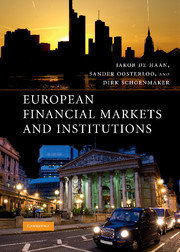Book contents
- Frontmatter
- Contents
- List of Boxes
- List of Figures
- List of Tables
- List of Countries
- List of Abbreviations
- Preface
- Part I Setting the Stage
- Part II Financial Markets
- Part III Financial Institutions
- 6 The Role of Institutional Investors
- 7 European Banks
- 8 The Financial System of the New Member States
- 9 European Insurers and Financial Conglomerates
- Part IV Policies for the Financial Sector
- Index
- References
6 - The Role of Institutional Investors
from Part III - Financial Institutions
- Frontmatter
- Contents
- List of Boxes
- List of Figures
- List of Tables
- List of Countries
- List of Abbreviations
- Preface
- Part I Setting the Stage
- Part II Financial Markets
- Part III Financial Institutions
- 6 The Role of Institutional Investors
- 7 European Banks
- 8 The Financial System of the New Member States
- 9 European Insurers and Financial Conglomerates
- Part IV Policies for the Financial Sector
- Index
- References
Summary
OVERVIEW
Over the last decades, the intermediation of financial assets has gradually shifted from banks towards institutional investors, such as pension funds, life insurance companies, and mutual funds. In this process of re-intermediation, the assets of institutional investors of the EU-15 countries tripled from 44 per cent of GDP in 1985 to 122 per cent in 2004.
This chapter starts off with an overview of the growth of institutional investors over the last two decades. The development of the main types of institutional investors is documented. There is a small group of countries with large-scale funded pensions (Denmark, Finland, Ireland, the Netherlands, and the United Kingdom). Other countries rely more on life insurance and mutual funds. New types of institutional investment, such as hedge funds and private equity, are also discussed.
Both the demand side (growing investments by pension funds to cater for ageing, and by mutual funds to accommodate wealth accumulation of households) and the supply side (shift from bank-financing to market-financing) point to further growth of institutional investment. There is no substantial institutional investment yet in the new EU Member States, but institutional investors in these countries are expected to grow in line with economic development.
This chapter also analyses the impact of institutional investors on the functioning of the financial system. Institutional investors are pooling funds and transferring economic resources over different asset classes and countries. They also transfer resources over time. Moreover, they increase the efficiency of the financial system.
- Type
- Chapter
- Information
- European Financial Markets and Institutions , pp. 167 - 203Publisher: Cambridge University PressPrint publication year: 2009



